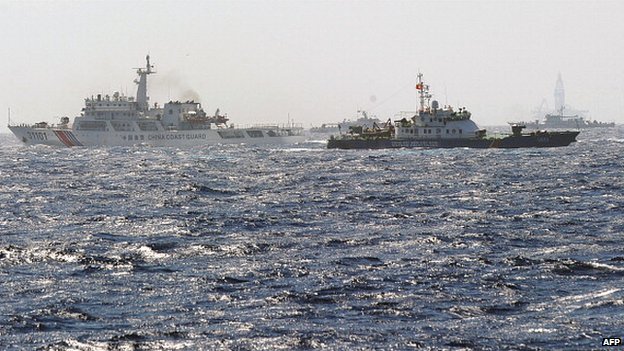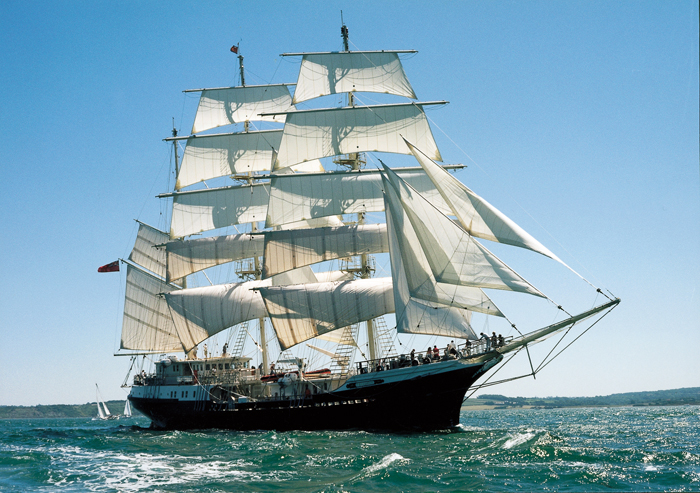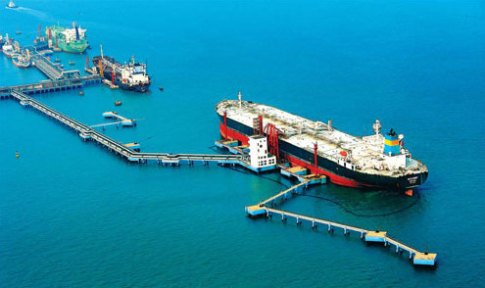by Richard Scott,
Visiting Lecturer, Greenwich Maritime Institute and MD, Bulk Shipping Analysis
It could be called ‘the China decade’. World seaborne trade maintained a four percent average annual rate of growth during the past ten years, slightly better than the previous ten-year average. This achievement was especially notable in the light of the global economy’s evolution, featuring a wrenching severe recession. But trade growth at that rate would have been impossible without China’s super-size contribution.
During the past decade, from 2003 to 2013, in numerous highly visible ways, global maritime activities which already had been penetrated were then dominated by China’s presence. This pattern is still ongoing, and signs suggest that it will continue for many years ahead. One of the most important aspects of the trend is the phenomenal expansion of China’s seaborne trade, especially imports.
Other countries contributed rising import demand to world trade as well, but none as spectacularly as China. Until 2008, the global economy as a whole was advancing at a robust pace, providing a broadly favourable backdrop for seaborne imports into most areas. After the 2009 recession, economic activity picked up again, although beyond the initial rebound many countries struggled to make further progress against prevailing headwinds. These were difficult circumstances for trade to resume brisk and sustained expansion, yet that is what happened: world seaborne trade as a whole averaged over four percent growth in 2011 to 2013, returning to its ‘normal’ trajectory.
Goliath task for the shipping industry
Commercial shipping’s existence is mainly related to transporting cargoes. Rapid expansion of trade in goods explains why the world fleet of ships saw such strong growth over the past ten years. The huge trade enlargement recorded was remarkable, since this period included the global ‘Great Recession’ in late 2008, continuing through 2009, following the world financial crisis. That slump was widely seen as the most damaging setback for the world economy since the Great Depression in the 1930s. Global economic activity contracted, world seaborne trade was badly weakened and, unusually for an individual year, 2009 saw an actual decline in annual trade volume.
A few statistics emphasise how the pattern of trade evolved in the past decade. In 2003, world seaborne trade – including dry bulk commodities, oil, liquefied gas, manufactured goods (mainly container shipments) and all other cargoes – totalled 6,676 million tonnes. Ten years later, in 2013, the overall total reached an estimated 9,914mt, based on Clarksons Research calculations, cumulatively a 48.5 percent rise. Looking at individual years, a break in the trend is immediately evident. In 2009 there was a four percent reduction from the previous twelve months, followed by a swift ten percent bounceback in 2010. The general pattern was very positive including, significantly, the latest few years of the period up to 2013.
That is the broad picture, but the development pattern among the individual cargo sectors differed markedly. What is abundantly clear is that dry bulk trade made the biggest contribution to the overall advance. Global dry bulk commodity movements, which comprised 2,453mt (37 percent of the total) in 2003, expanded by seventy-six percent to an estimated 4,309mt in 2013, raising their share of the total to 43 percent. Container shipments also grew rapidly, rising by ninety percent, reaching 1,524mt. The second largest sector, oil (crude oil plus processed oil products) was a laggard, growing by a relatively modest twenty-one percent to 2,834mt over the ten years’ period.
A large part of this expansion, particularly in the dry bulk sector, was attributable to China’s multiplying appetite for imports. An especially valuable contribution to the global seaborne trade trend was seen in 2009. As already mentioned, trade declined in that year, but the downturn might have been much worse than actually occurred. A huge jump in China’s dry bulk commodity purchases, completely opposite to the pattern elsewhere, prevented a much greater overall decline.
Sea trade in the ten years ending 2013 as a whole was strengthened by many other countries needing increasing imports. A particularly substantial volume of imported cargo movements was added in Asia, alongside China’s additional volumes. Numerous countries in this region, including India, South Korea, Taiwan and smaller buyers, greatly raised purchases of dry bulks, oil, gas and manufactures. Further cargo import quantities were contributed by countries elsewhere around the world.
Figures for seaborne trade compiled by UNCTAD (United Nations Conference on Trade and Development) emphasise how the Asian region led global cargo movements growth. Roughly four-fifths of the entire growth in trade recorded during the period from 2003 to 2012 (currently the latest year for which these statistics are available) was attributable to extra imports into Asia. Another feature, related to the remaining approximately one-fifth of trade growth, is evidence of a reduction in Europe’s imports, a decreasing tendency in North America and a flattish trend in Japan. By contrast both the Middle East area, and a group of all other countries together, showed considerable imports increases.
The real giant awakes
China’s share of global seaborne trade has risen enormously, resulting from its imports growth comprising a very large proportion of world imports growth. As well as providing more cargoes for a greatly increasing China-owned fleet of ships, this upsurge benefited many independent shipowners in numerous countries and, through part of the period, proved highly profitable. Since 2008, however, variable overcapacity in world shipping markets has suppressed earnings for shipping investors.
In the early 2000s, China’s imports of all cargoes – dry bulks, oil, gas and manufactured goods (mostly container shipments) – comprised 5-6 percent of the world seaborne trade total. Global import demand then was still dominated by European countries, Japan and other Asian countries. Starting in 2003, rapid and sustained expansion in China began. Within ten years, a relatively short historical period, a dramatic transformation had occurred. This resulted in China’s share of world seaborne trade expanding almost fourfold from the early millennium, reaching an estimated 20.4 percent in 2013.
The giant’s emergence as an economic powerhouse affecting the world had occurred earlier. In a memorable comment attributed to him, the famous nineteenth century French Emperor Napoleon Bonaparte foreshadowed the eventual impact when he suggested that China’s awakening would shake the world. But such a cataclysmic event was a long time coming. It started happening in 1979 when China’s paramount leader, Deng Xiaoping, began opening up the economy to world trade, bringing the country’s extended ‘slumber’ to a close.
By the 1990s successive reforms had enabled the Chinese economy to achieve many years of very rapid expansion. Because this development was partly based on export sales, particularly manufactured goods, China became a major and then dominant supplier of these products to the world market. There were huge consequences for the maritime scene: seaborne trade patterns in the container shipping sector changed greatly. The world’s new ‘workshop’ became solidly established. But an even larger impact on global maritime trade was still some way ahead, in the new millennium.
During the early 2000s China began focusing on additional external raw materials and fuels supplies amid rapidly expanding industrial output. More agricultural products were also needed. Although domestic resources of many commodities were widely available, these were insufficient in volume and sometimes in quality as well. Industries including steelmaking, power generation, aluminium smelting, and animal feed manufacturing started placing much heavier emphasis on seeking supplies from foreign sources. The strong advance in quantities imported was the result.
Growing annual seaborne imports into China also formed rising percentages of the upwards overall global trade volumes trend. Statistics illustrate how significant this pattern has been for the global shipping industry, which now depends upon China for a substantial proportion of its bulk carrier, tanker and other ship employment. In 2003 China’s seaborne imports totalled just under 500 million tonnes, within a global total of 6,680mt. By 2013 the China volume had risen to 2,026mt within a global 9,914mt total. These Clarksons Research figures emphasise China’s significance for shipping companies, indicating that, during the 2003-2013 period, annual world seaborne trade rose by 49 percent, while within this volume China’s element increased by 305 percent.
The figures quoted here underline how world seaborne trade has risen greatly, and how a large part of that expansion reflected China’s much more rapidly growing imports. From the angle of additional ship employment created, this point is reinforced by looking at the percentages showing what proportion of growth in world seaborne trade volume during the ten years’ period was comprised of China’s expanding imports. It then becomes even more abundantly clear why global shipping industry players are so intently focused on how Chinese industry and agriculture is progressing, the implications for imports, and the evolving relationship between ‘home’ domestic commodity output and import demand.
As already outlined, global seaborne trade grew substantially from 2003 to 2013. Arguably the most spectacular positive feature during the period was that almost one half (47 percent) of the expansion was contributed by additional imports into China. For dry bulk commodities, the contribution was even larger, and therefore even more striking. China’s extra imports of these commodities (raw materials, fuels, other bulk industrial products, soyabeans and other bulk agricultural products), formed fully two-thirds or 66 percent of overall world seaborne trade growth within the sector. Consequently, shipping industry participants are still transfixed by the China theme.
In a range of key individual trades – iron ore, steam coal (used mainly in power stations), soyabeans, bauxite/alumina, nickel ore, crude oil – China has become either by far the biggest importer or one of the biggest. Expanding Chinese import volumes have been, or in some cases continue to be, the main component of global growth in large-scale trades. Shipowners, charterers, brokers and analysts as well as many others are therefore always looking for any clues about key influences: how demand for the products made by relevant industries are developing, what impact there will be on output levels, and what other factors will determine how much raw materials and other inputs will change as a result.
Among individual commodities, iron ore imports into China experienced, over the past ten years, one of the most dazzling performances ever seen in the long history of global maritime trade. China’s iron ore imports have become gigantic, employing a vast armada of bulk carriers, after rising well over five-fold, from 148mt in 2003 to 820mt in 2013. As a result, these now have a dominant role in world seaborne iron ore movements (one of the largest commodity trades), comprising about two-thirds of the total. Moreover, the 2014 China volume could exceed 900mt. Another example of a large volume trade is coal imports, which rose steeply by over seven-fold in the past five years, from 44mt in 2008 to 327mt in 2013. Crude oil and products imports into China by sea in the past ten years also increased robustly, more than doubling from 114mt, to 293mt last year.
A galloping horse
What seems clear is that China will remain a prominent part of global seaborne trade, and probably a key contributor to its growth, over many years into the future. That is not just a wildly optimistic appraisal. Certainly the country’s economic activity is slowing, and the trend may persist, consistent with a maturing economy. This feature reflects the switch of emphasis, from a demand viewpoint, towards consumer spending and away from capital investment (especially infrastructure projects) and exports. Looking at the economy’s supply side, a switch from manufacturing towards services is foreseen. But, while these forces will restrain production of goods with high raw materials content, further growth in imported natural resources and energy is likely.
The Year of the Horse, 2014, in China seems set to prove another period of increases in many commodity imports, and that trend may continue in the medium term at least. There are positive indicators, although the earlier gallop may be moderating towards a fast trot. Nevertheless, there are also reasons for caution or uncertainty about the outlook. Several questions arise. How rapidly will the economy grow in the years ahead? What, precisely, will be the relationship between economic activity and seaborne trade? Is growth in import demand for commodities likely to continue outpacing production increases in dependent industries? How will foreign purchases of agricultural commodities evolve? Answers involve a complex range of factors which are far from easy to assess reliably.
Also relevant to the general picture of world maritime trade’s progress is the contribution of other prominent players around the globe. A detailed examination of export suppliers is beyond the scope of this article. As import generating areas, other Asian countries, and Japan and Europe as well as the USA are particularly significant. Also, some emerging economies in the Middle East, South America and Africa are becoming more prominent influences. Currently the advanced economies group (mainly Europe, USA and Japan) is still having difficulty shaking off the long term debilitating effects of the 2009 recession and its problematical aftermath, with adverse implications for seaborne trade. Until there is a stronger import purchases trend in these countries, world seaborne trade’s great reliance and concentrated focus on China will persist.














